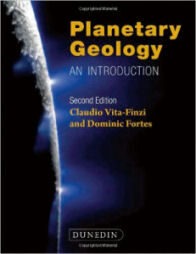By Claudio Vita-Finzi and Dominic Fortes

It is a wonderful state of affairs that we can not only now write detailed books about planetary geology and geomorphology of the bodies in the solar system, but we can also illustrate them with wonderful photographs.
Of course, this has everything to do with the ever more planetary missions undertaken by the various national bodies (including NASA and the European Space Agency), so we are now in a position to start to consider the geology of solid planets and satellites other than our own.
This exciting prospect has resulted in the surprising discovery that geological processes similar to those studied by geologists on earth are going on elsewhere in the solar system. And we are discovering that the inert and boring lumps of rock that accompany us around the sun turn out to be anything but – they are active tectonically, and experience eruptions, landslides and dust storms just like our own planet.
With this in mind, Planetary Geology is aimed at both the student geologist and amateur enthusiast; and provides an up-to-date coverage of recent advances in planetary geology. In particular, it discusses planetary origins, their orbits and cycles, their cores, mantles and crusts, their magnetic fields, topography and gravity, their tectonics and volcanism, impacts and impactors, atmospheres, oceans and ice caps, erosion, deposition and stratigraphy, and even planetary biology. The irony is that this list could easily be about geology on earth, rather than our distant companions in the solar system.
The guide also includes a full glossary of terms used in the guide and full colour diagrams to accompany the text, as you would expect. However, not surprisingly, it is the photos that are most exciting. As Charles Darwin is quoted as writing in the Voyage of the Beagle:
How great would be the desire in every admirer of nature to behold, if such were possible, the scenery of another planet”
Claudio Vita-Finzi currently works at the Natural History Museum in London on solar history, after having taught at University College, London (UCL). Dominic Fortes currently works at the Institute for Earth and Planetary Science at UCL and Birkbeck College in London, and is studying planetary ices and the evolution of these bodies.
Planetary Geology: An Introduction (2nd edition), by Claudio Vita-Finzi and Dominic Fortes, Dunedin, Edinburgh (2015), 206 pages (paperback), ISBN: 978-17-80460-15-4


